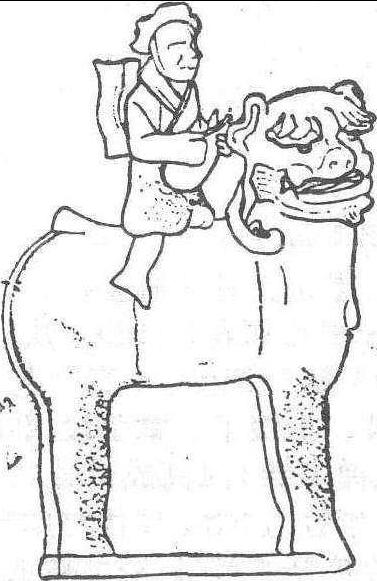胡人骑狮辽瓷像
辽代瓷器。1984在内蒙古自治区敖汉旗撤力巴乡喇嘛沟村出土。通高14.5,长9,宽4厘米。为雄狮,侧首立于长方形底座上。张口伸舌,双且直视,颈挂一铃,背部有鞍鞯。上偏坐一胡人,半侧身。头戴花瓣状卷沿帽,两侧系绳在颌下打结。胡人突额,深目高鼻,大胡须,颈部戴围巾,手戴手套。双手抱一琵琶并作弹拨状,背负一壶。壶系白瓷略泛青,一侧呈弯弧状,外侧起棱。壶与狮腿有黑斑点。胡人身着长衣为淡红色釉,局部有细开片。是一件十分难得的辽瓷工艺品。今藏敖汉旗文管所。

胡人骑狮辽瓷像
| 词条 | 胡人骑狮辽瓷像 |
| 类别 | 中文百科知识 |
| 释义 | 胡人骑狮辽瓷像辽代瓷器。1984在内蒙古自治区敖汉旗撤力巴乡喇嘛沟村出土。通高14.5,长9,宽4厘米。为雄狮,侧首立于长方形底座上。张口伸舌,双且直视,颈挂一铃,背部有鞍鞯。上偏坐一胡人,半侧身。头戴花瓣状卷沿帽,两侧系绳在颌下打结。胡人突额,深目高鼻,大胡须,颈部戴围巾,手戴手套。双手抱一琵琶并作弹拨状,背负一壶。壶系白瓷略泛青,一侧呈弯弧状,外侧起棱。壶与狮腿有黑斑点。胡人身着长衣为淡红色釉,局部有细开片。是一件十分难得的辽瓷工艺品。今藏敖汉旗文管所。
胡人骑狮辽瓷像 |
| 随便看 |
开放百科全书收录579518条英语、德语、日语等多语种百科知识,基本涵盖了大多数领域的百科知识,是一部内容自由、开放的电子版国际百科全书。